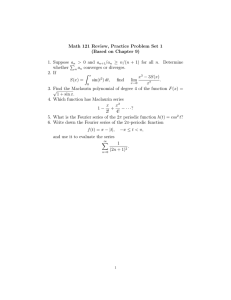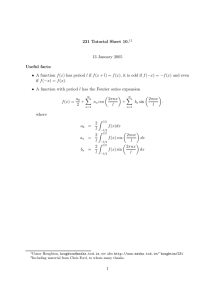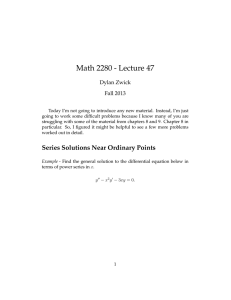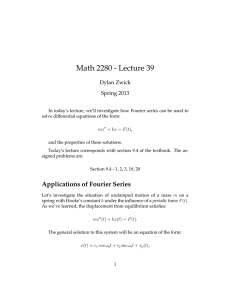Math 2280 - Lecture 39 Dylan Zwick Spring 2013
advertisement
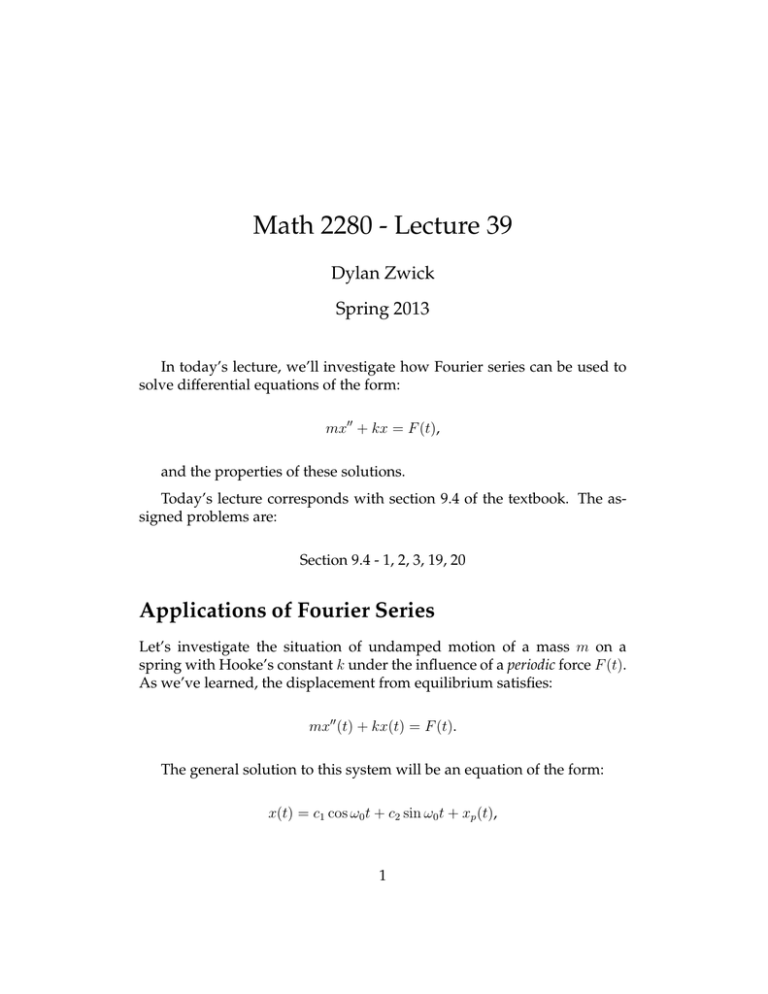
Math 2280 - Lecture 39 Dylan Zwick Spring 2013 In today’s lecture, we’ll investigate how Fourier series can be used to solve differential equations of the form: mx′′ + kx = F (t), and the properties of these solutions. Today’s lecture corresponds with section 9.4 of the textbook. The assigned problems are: Section 9.4 - 1, 2, 3, 19, 20 Applications of Fourier Series Let’s investigate the situation of undamped motion of a mass m on a spring with Hooke’s constant k under the influence of a periodic force F (t). As we’ve learned, the displacement from equilibrium satisfies: mx′′ (t) + kx(t) = F (t). The general solution to this system will be an equation of the form: x(t) = c1 cos ω0 t + c2 sin ω0 t + xp (t), 1 p where ω0 = k/m is the natural frequency of the system and xp (t) is a particular solution to the differential equation. Here we want to use Fourier series to find a periodic particular solutions of the differential equation, which we will denote xsp (t) and call the steady periodic solution. We will assume for simplicity that F (t) is an odd functions with period 2L, so its Fourier series has the form F (t) = ∞ X Bn sin n=1 nπt . L If nπ/L is not equal to ω0 for any positive integer n, we can determine a steady periodic solution of the form xsp (t) = ∞ X n=1 bn sin nπt L by substituting the series into our differential equation and equating the coefficients. Let’s see an example of how to do this. Example - Suppose that m = 2kg, k = 32N/m, and that F (t) is the odd periodic force with period 2s given in one period by F (t) = 10N 0 < t < 1; −10N 1 < t < 2. 2 More room for example problem. 3 Now, what happens if nπ/L happens to equal ω0 for some value of n? In this case, we get resonance, or, more precisely, pure resonance. The reason is that the equation mx′′ + kx = BN sin ω0 t has the resonance solution x(t) = − BN t cos ω0 t 2mω0 p k/m. The particular solution we get using Fourier series if ω0 = methods is then x(t) = X −BN nπt BN t cos ω0 t + sin . 2 2mω0 m(ω0 − n2 π 2 /L2 ) L n6=N Example - Suppose that m = 2 and k = 32. Determine whether pure resonance will occur if F (t) is the odd periodic function defined in one period to be: (a) - F (t) = 10 0<t<π −10 π < t < 2π (b) - F (t) = 10t, for −π < t < π. 4 More room for example problem. 5 Even if we don’t have resonance, we can have near resonance, where a single term in the solution has a frequency that is close to the natural resonant frequency, and is magnified. Example - Find a steady periodic solution to x′′ + 10x = F (t), where F (t) is the period 4 function with F (t) = 5t for −2 < t < 2 and Fourier series ∞ 20 X (−1)n+1 nπt F (t) = sin . π n=1 n 2 6
